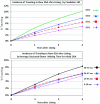The interplay of socioeconomic status, distance to center, and interdonor service area travel on kidney transplant access and outcomes
- PMID: 20798250
- PMCID: PMC2994090
- DOI: 10.2215/CJN.04940610
The interplay of socioeconomic status, distance to center, and interdonor service area travel on kidney transplant access and outcomes
Abstract
Background and objectives: Variation in kidney transplant access across the United States may motivate relocation of patients with ability to travel to better-supplied areas.
Design, setting, participants, & measurements: We examined national transplant registry and U.S. Census data for kidney transplant candidates listed in 1999 to 2009 with a reported residential zip code (n = 203,267). Cox's regression was used to assess associations of socioeconomic status (SES), distance from residence to transplant center, and relocation to a different donation service area (DSA) with transplant access and outcomes.
Results: Patients in the highest SES quartile had increased access to transplant compared with those with lowest SES, driven strongly by 76% higher likelihood of living donor transplantation (adjusted hazard ratio [aHR] 1.76, 95% confidence interval [CI] 1.70 to 1.83). Waitlist death was reduced in high compared with low SES candidates (aHR 0.86, 95% CI 0.84 to 0.89). High SES patients also experienced lower mortality after living and deceased donor transplant. Patients living farther from the transplant center had reduced access to deceased donor transplant and increased risk of post-transplant death. Inter-DSA travel was associated with a dramatic increase in deceased donor transplant access (HR 1.94, 95% CI 1.88 to 2.00) and was predicted by high SES, white race, and longer deceased-donor allograft waiting time in initial DSA.
Conclusions: Ongoing disparities exist in kidney transplantation access and outcomes on the basis of geography and SES despite near-universal insurance coverage under Medicare. Inter-DSA travel improves access and is more common among high SES candidates.
Figures




Similar articles
-
Following the organ supply: assessing the benefit of inter-DSA travel in liver transplantation.Transplantation. 2013 Jan 27;95(2):361-71. doi: 10.1097/TP.0b013e3182737cfb. Transplantation. 2013. PMID: 23250334
-
Association between Longer Travel Distance for Transplant Care and Access to Kidney Transplantation and Graft Survival in the United States.J Am Soc Nephrol. 2021 May 3;32(5):1151-1161. doi: 10.1681/ASN.2020081242. Epub 2021 Mar 12. J Am Soc Nephrol. 2021. PMID: 33712528 Free PMC article.
-
The impact of socioeconomic status and geographic remoteness on access to pre-emptive kidney transplantation and transplant outcomes among children.Pediatr Nephrol. 2016 Jun;31(6):1011-9. doi: 10.1007/s00467-015-3279-z. Epub 2015 Dec 21. Pediatr Nephrol. 2016. PMID: 26692022
-
Disparities, race/ethnicity and access to pediatric kidney transplantation.Curr Opin Nephrol Hypertens. 2013 May;22(3):336-43. doi: 10.1097/MNH.0b013e32835fe55b. Curr Opin Nephrol Hypertens. 2013. PMID: 23508056 Free PMC article. Review.
-
Kidney transplant tourism: cases from Canada.Med Health Care Philos. 2013 Nov;16(4):921-4. doi: 10.1007/s11019-012-9450-4. Med Health Care Philos. 2013. PMID: 23192569 Review.
Cited by
-
Distinct clinical profiles and post-transplant outcomes among kidney transplant recipients with lower education levels: uncovering patterns through machine learning clustering.Ren Fail. 2023;45(2):2292163. doi: 10.1080/0886022X.2023.2292163. Epub 2023 Dec 12. Ren Fail. 2023. PMID: 38087474 Free PMC article.
-
How important is social support in determining patients' suitability for transplantation? Results from a National Survey of Transplant Clinicians.J Med Ethics. 2018 Oct;44(10):666-674. doi: 10.1136/medethics-2017-104695. Epub 2018 Jun 28. J Med Ethics. 2018. PMID: 29954874 Free PMC article.
-
Assessing Transplant Education Practices in Dialysis Centers: Comparing Educator Reported and Medicare Data.Clin J Am Soc Nephrol. 2015 Sep 4;10(9):1617-25. doi: 10.2215/CJN.09851014. Epub 2015 Aug 20. Clin J Am Soc Nephrol. 2015. PMID: 26292696 Free PMC article.
-
The association of socioeconomic status on kidney transplant access and outcomes: a nationwide cohort study in Taiwan.J Nephrol. 2024 Jul;37(6):1563-1575. doi: 10.1007/s40620-024-01928-5. Epub 2024 Apr 18. J Nephrol. 2024. PMID: 38635122 Free PMC article.
-
Factors associated with statural growth in pediatric kidney transplant recipients with focus on metabolic acidosis.Pediatr Nephrol. 2025 Jun;40(6):2059-2070. doi: 10.1007/s00467-025-06663-y. Epub 2025 Jan 27. Pediatr Nephrol. 2025. PMID: 39865159
References
-
- Department of Health and Human Services: The “Final Rule”. Available at: http://www.gaonet.gov/special.pubs/organ/appendd.pdf Accessed August 29, 2009.
-
- Roberts JP, Wolfe RA, Bragg-Gresham JL, Rush SH, Wynn JJ, Distant DA, Ashby VB, Held PJ, Port FK: Effect of changing the priority for HLA matching on the rates and outcomes of kidney transplantation in minority groups. N Engl J Med 350: 545–551, 2004 - PubMed
-
- Mitchell BD, Stern MP, Haffner SM, Hazuda HP, Patterson JK: Risk factors for cardiovascular mortality in Mexican Americans and non-Hispanic whites. San Antonio Heart Study. Am J Epidemiol 131: 423–433, 1990 - PubMed
-
- Ellison MD, Edwards LB, Edwards EB, Barker CF: Geographic differences in access to transplantation in the United States. Transplantation 76: 1389–1394, 2003 - PubMed
-
- Roberts JP, Dykstra DM, Goodrich NP, Rush SH, Merion RM, Port FK: Geographic differences in event rates by model for end-stage liver disease score. Am J Transplant 6: 2470–2475, 2006 - PubMed
Publication types
MeSH terms
Grants and funding
LinkOut - more resources
Full Text Sources
Medical

